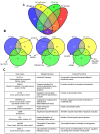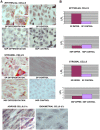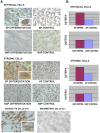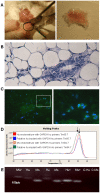Human endometrial side population cells exhibit genotypic, phenotypic and functional features of somatic stem cells
- PMID: 20585575
- PMCID: PMC2891991
- DOI: 10.1371/journal.pone.0010964
Human endometrial side population cells exhibit genotypic, phenotypic and functional features of somatic stem cells
Abstract
During reproductive life, the human endometrium undergoes around 480 cycles of growth, breakdown and regeneration should pregnancy not be achieved. This outstanding regenerative capacity is the basis for women's cycling and its dysfunction may be involved in the etiology of pathological disorders. Therefore, the human endometrial tissue must rely on a remarkable endometrial somatic stem cells (SSC) population. Here we explore the hypothesis that human endometrial side population (SP) cells correspond to somatic stem cells. We isolated, identified and characterized the SP corresponding to the stromal and epithelial compartments using endometrial SP genes signature, immunophenotyping and characteristic telomerase pattern. We analyzed the clonogenic activity of SP cells under hypoxic conditions and the differentiation capacity in vitro to adipogenic and osteogenic lineages. Finally, we demonstrated the functional capability of endometrial SP to develop human endometrium after subcutaneous injection in NOD-SCID mice. Briefly, SP cells of human endometrium from epithelial and stromal compartments display genotypic, phenotypic and functional features of SSC.
Conflict of interest statement
Figures







Similar articles
-
Endometrial stem/progenitor cells: the first 10 years.Hum Reprod Update. 2016 Mar-Apr;22(2):137-63. doi: 10.1093/humupd/dmv051. Epub 2015 Nov 9. Hum Reprod Update. 2016. PMID: 26552890 Free PMC article. Review.
-
Reconstruction of endometrium from human endometrial side population cell lines.PLoS One. 2011;6(6):e21221. doi: 10.1371/journal.pone.0021221. Epub 2011 Jun 21. PLoS One. 2011. PMID: 21712999 Free PMC article.
-
Stem cell-like properties of the endometrial side population: implication in endometrial regeneration.PLoS One. 2010 Apr 28;5(4):e10387. doi: 10.1371/journal.pone.0010387. PLoS One. 2010. PMID: 20442847 Free PMC article.
-
Endometrial stem cells.Curr Opin Obstet Gynecol. 2007 Aug;19(4):377-83. doi: 10.1097/GCO.0b013e328235a5c6. Curr Opin Obstet Gynecol. 2007. PMID: 17625422 Review.
-
The mouse endometrium contains epithelial, endothelial and leucocyte populations expressing the stem cell marker telomerase reverse transcriptase.Mol Hum Reprod. 2016 Apr;22(4):272-84. doi: 10.1093/molehr/gav076. Epub 2016 Jan 5. Mol Hum Reprod. 2016. PMID: 26740067 Free PMC article.
Cited by
-
Mesenchymal-to-epithelial transition contributes to endometrial regeneration following natural and artificial decidualization.Stem Cells Dev. 2013 Mar 15;22(6):964-74. doi: 10.1089/scd.2012.0435. Epub 2013 Jan 29. Stem Cells Dev. 2013. PMID: 23216285 Free PMC article.
-
Stem Cell-Based Therapy for Asherman Syndrome: Promises and Challenges.Cell Transplant. 2021 Jan-Dec;30:9636897211020734. doi: 10.1177/09636897211020734. Cell Transplant. 2021. PMID: 34105392 Free PMC article. Review.
-
Adult stem cells in endometrial regeneration: Molecular insights and clinical applications.Mol Reprod Dev. 2021 Jun;88(6):379-394. doi: 10.1002/mrd.23476. Epub 2021 May 20. Mol Reprod Dev. 2021. PMID: 34014590 Free PMC article. Review.
-
Unremitting cell proliferation in the secretory phase of eutopic endometriosis: involvement of pAkt and pGSK3β.Reprod Sci. 2015 Apr;22(4):502-10. doi: 10.1177/1933719114549843. Epub 2014 Sep 6. Reprod Sci. 2015. PMID: 25194152 Free PMC article.
-
Endometrial stem/progenitor cells: the first 10 years.Hum Reprod Update. 2016 Mar-Apr;22(2):137-63. doi: 10.1093/humupd/dmv051. Epub 2015 Nov 9. Hum Reprod Update. 2016. PMID: 26552890 Free PMC article. Review.
References
-
- Prianishnikov VA. On the concept of stem cell and a model of functional-morphological structure of the endometrium. Contraception. 1978;18(3):213–23. - PubMed
-
- Padykula AH. Regeneration in the primate uterus: the role of stem cells. Ann N Y Acad Sci. 1991;622:47–56. - PubMed
-
- Reynolds BA, Weiss S. Generation of neurons and astrocytes from isolated cells of the adult mammalian central nervous system. Science. 1992;255(5052):1646. - PubMed
-
- Gage FH. Structural plasticity: cause, result, or correlate of depression. Biol Psychiatry. 2000;48(8):713–4. - PubMed
-
- Bjerknes M, Cheng H. Clonal analysis of mouse intestinal epithelial progenitors. Gastroenterology. 1999;116:208–10. - PubMed
Publication types
MeSH terms
LinkOut - more resources
Full Text Sources
Other Literature Sources
Medical
Molecular Biology Databases

